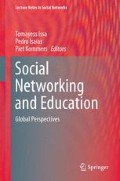Abstract
To understand and affiliate themselves with the feelings of their own kind seems to be an inherent feature of mankind. Social networking sites are the product of this drive in the context of the modern world whose outlook has been completely changed by the advent of technology. It is a medium to virtually connect a multitude of people around the world through the internet. “Man is by nature a social animal”. This claim by Aristotle has stood the test of time. For this reason, humans want to interact with one another through communication channels. The internet has completely changed the face of world communication. Web 2.0 technology allows the people worldwide to communicate with each another more easily, frequently, timelessly and inexpensively to promote business, commerce, health care, school and universities etc. In such demanding contexts, social networking (via social networking sites) is used in different sectors such as government, health and commerce. In addition, higher education is seriously considering its implementations for e-teaching, e-learning and e-marketing. Universities and other education institutions have realized that Web 2.0 tools such as Facebook and Twitter have great potential to create constructive communication between students and teachers; therefore, they are considering them as well as other Web 2.0 features (blog, wiki, blackboard etc.) for pedagogical purposes. On the one hand, different researchers are discovering numerous positive factors (advantages) of social networking; on the other hand, they are also confronting negative factors (risks) of social networking. These risks and advantages are different in different countries because of varying security and privacy policies and cultural and moral issues. Before implementing these tools and technologies in higher education, it is important to do research demographically to know exactly what risks and advantages are related to different regions. Accordingly, this research focuses on Pakistan’s higher education sector. Therefore, for the data collection, only university students were targeted from different universities in Pakistan. An online survey was conducted and more than 150 participants’ valid responses were used for data analysis. The findings are based on four positive factors (advantages) and five negative factors (risks) associated with the use of social networking in higher education in Pakistan. Some recommendations are given to mitigate those risks and maximize the benefits of opportunities for facilitating students, teacher and institution. In conclusion, this research has pinpointed directly and precisely the advantages and risks (positive and negative factors) of using social networking in the higher education sector in Pakistan.
Access this chapter
Tax calculation will be finalised at checkout
Purchases are for personal use only
References
Aghaei S, Nematbakhsh MA, Farsani HK (2012) Evolution of the World Wide Web: from Web 1.0 to Web 4.0. Int J Web Seman Technol 3(1):1–10
Alkindi SSA, Alhashmi SM (2012) Use of social networking sites among shinas college of technology students in Oman. J Inf Knowl Manage 11(01):1250002-1250001–1250002-1250009
Almeida F (2012) Web 2.0 techonologies and social networking security fears in enterprises. Int J Adv Comput Sci Appl 3(2):152–156
Altbach PG, Reisberg L, Rumbley LE (2009) Trends in global higher education: tracking an academic revolution, pp 1–246
Darwish A, Lakhtaria KI (2011) The Impact of the New Web 2.0 technologies in communication, development, and revolutions of societies. J Adv Inf Technol 2(4):204–216
Dillmn D (2000) Mail and internet surveys: the tailored design method. Wiley. http://web.mit.edu/subjectevaluation/docs/TLL_ItemWritingTips-2.pdf. Accessed 11 sept 2014
Dorn J (2010) Social software (and Web 2.0)
Fuchs C, Hofkirchner W, Schafranek M, Raffl C, Sandoval M, Bichler aR (2010) Theoretical foundations of the web: cognition, communication, and co-operation. Towards an understanding of web 1.0, 2.0, 3.0 2 (1):41–59
Gephart R (1999) Paradigms and research methids, vol 4
Gülbahar Y (2013) Social networks from higher education students’ perspective. Anadolu J Educ Sci Int 3(2):22–32
Hamid S, Chang S, Kurnia S (2009) Identifying the use of online social networking in higher education 419–422
Hamid S, Waycott J, Chang S, Kurnia S (2011) Appropriating online social networking (OSN) activities for higher education: two Malaysian cases
Harris AL, Rea A Web 2.0 and virtual world technologies: a growing impact on IS education. J Inf Syst Educ 20(2):137–144
Mills A, Chen R, Lee J, Rao HR (2009) Web 2.0 emergency applications: how useful can twitter be for emergency response? Twitter for Emergency Management and Mitigation
Quantitative, Positivist Research Methods in Information Systems. (2013). http://dstraub.cis.gsu.edu/quant/2philo.asp. Accessed 12/10/2014 2014
Rouse M (2011) Social search engine. http://whatis.techtarget.com/definition/social-search-engine. Accessed 11 Nov 2014
Social Media use in the Industrial Sector. IHS GlobalSpec Research Report
Vanessa D (2013) Social media analytics and the health Sector. https://www.hashtags.org/how-to/search/social-media-analytics-and-the-health-sector/. Accessed 26 Sept 2014 014
Wills K What is quantitiative research. http://www.marketingdonut.co.uk/marketing/market-research/what-is-quantitative-research. Accessed 10 Aug 2014 2014
Author information
Authors and Affiliations
Corresponding author
Editor information
Editors and Affiliations
Rights and permissions
Copyright information
© 2016 Springer International Publishing Switzerland
About this chapter
Cite this chapter
Pervaiz, S. (2016). The Advantages and Risks of Using Social Networking in Higher Education in Pakistan. In: Issa, T., Isaias, P., Kommers, P. (eds) Social Networking and Education. Lecture Notes in Social Networks. Springer, Cham. https://doi.org/10.1007/978-3-319-17716-8_6
Download citation
DOI: https://doi.org/10.1007/978-3-319-17716-8_6
Published:
Publisher Name: Springer, Cham
Print ISBN: 978-3-319-17715-1
Online ISBN: 978-3-319-17716-8
eBook Packages: EducationEducation (R0)

